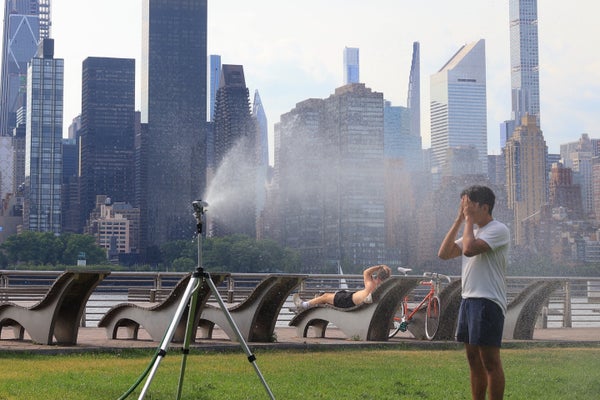Facing Heat Waves, Cities Ask Scientists to Help Them Protect People

Facing Scorching Heat Waves, Cities Call on Scientists to Understand How People Respond
Miami and New York City officials say they need more insight into how searing temperatures affect homeless people and other vulnerable populations

Sprinklers help people to cool off in Long Island City, N.Y., as temperatures soared on June 21, 2024.
Selcuk Acar/Anadolu via Getty Images
CLIMATEWIRE | U.S. cities want more research from scientists to help them handle extreme heat — especially the way high temperatures influence human behavior and health.
That was the message from a panel discussion Wednesday at Columbia University. Officials from Miami and New York City shared their heat research wishlists, and social studies — centered on high-risk populations — made the top of the list.
The use of cooling centers — specifically, who goes to them and why — was a big question for Isabelle Thomas, a policy adviser in the New York City mayor’s office.
On supporting science journalism
If you’re enjoying this article, consider supporting our award-winning journalism by subscribing. By purchasing a subscription you are helping to ensure the future of impactful stories about the discoveries and ideas shaping our world today.
“Why do people go to cooling centers? Why don’t people go to cooling centers?” she asked. “What is their perception of the urgency — or lack thereof — as it relates to extreme heat?”
She noted some communities face more risk from skyrocketing temperatures, such as outdoor workers and people experiencing homelessness. Better insight on the experiences of these vulnerable populations would help decisionmakers craft more effective heat-related policies.
“We still in New York City are lacking some data on occupational heat exposure and health impacts, specifically as it relates to food vendors and delivery workers and other workers who are outside in the city,” Thomas said.
Cities also need better data on the number of people who die or fall sick during heat waves, said Jane Gilbert, the chief heat officer in Miami-Dade County. As of right now, these estimates are often vastly undercounted.
Extreme temperatures can directly lead to heat exhaustion, heat stroke or even death. These cases are easy to spot. But heat can have indirect effects on human health as well, such as exacerbating preexisting health conditions, increasing the risk of workplace injuries or affecting mental health. These indirect effects often go unrecorded on hospitalization records or death certificates.
“Really, direct heat deaths, illnesses, hospitalizations is the tip of the iceberg of health impacts,” Gilbert said.
Studies investigating how many people are actually hospitalized or dying from extreme heat — as well as where it’s happening and which populations are the most affected — can help policymakers design better protections for vulnerable communities.
“For us to design and prioritize interventions, having that situational understanding of where these illnesses and deaths are — where that exposure is happening — is very important for us,” Gilbert said.
Worsening urban heat islands
Cities face some of the worst impacts of intensifying heat. That’s thanks to a phenomenon known as the urban heat island effect. Urban centers are often hotter than their rural surroundings, warmed by denser populations, more asphalt, darker surfaces and fewer trees.
There are also stark differences between neighborhoods within the same city, depending on their density and access to green space. And studies have found that low-income families and people of color are more likely to live in hotter neighborhoods.
That puts cities on the front lines of heat adaptation, with vulnerable populations facing the most risk.
Both New York and Miami have implemented heat action plans, with goals to expand cooling resources and dampen rising urban temperatures.
Miami’s plan calls for improved emergency response during heat waves, greater access to air conditioning and expanding the county’s tree canopy coverage. New York officials also aim to grow the city’s tree cover, and they’re working on establishing a maximum indoor air temperature policy for schools and other facilities.
Other cities across the country have plans of their own.
Phoenix and Los Angeles, like Miami, have hired chief heat officers. Cities from Philadelphia to Houston have designed emergency response plans for heat waves and developed plans to increase their heat resilience. Even King County in Washington, which includes Seattle, developed its first extreme-heat mitigation strategy after the record-breaking Pacific Northwest heat dome of 2021.
Still, experts say more action is needed as temperatures rise.
“Our lives have to change and our lifestyles have to change and the way that we go about our business and our daily lives during hot weather has to change,” Thomas said. “But it doesn’t necessarily have to be for the worst. I think we have a lot of opportunities to reshape the way that we’re experiencing our daily lives in order to accommodate and stay safe during extreme heat.”
Reprinted from E&E News with permission from POLITICO, LLC. Copyright 2024. E&E News provides essential news for energy and environment professionals.




